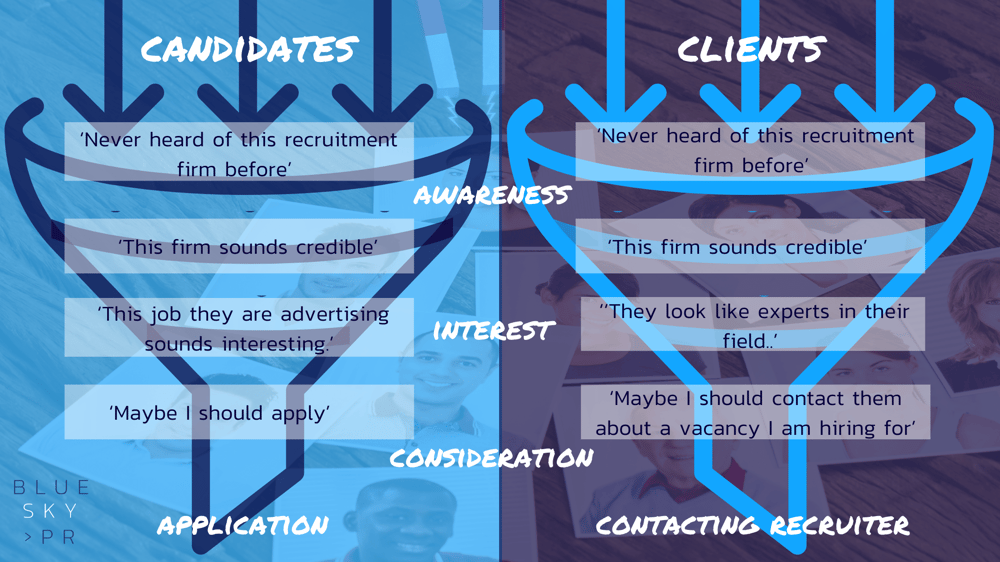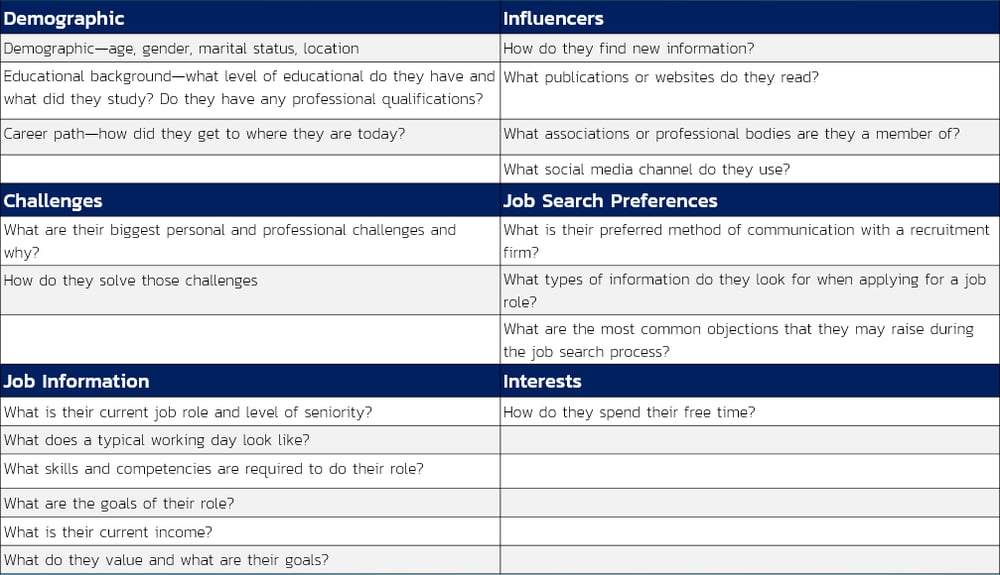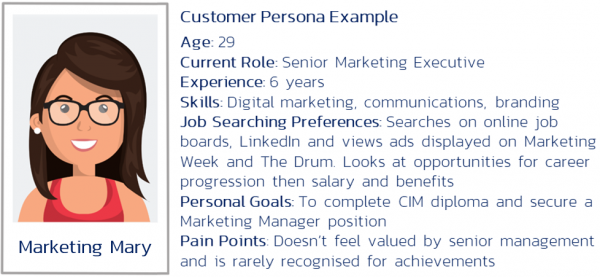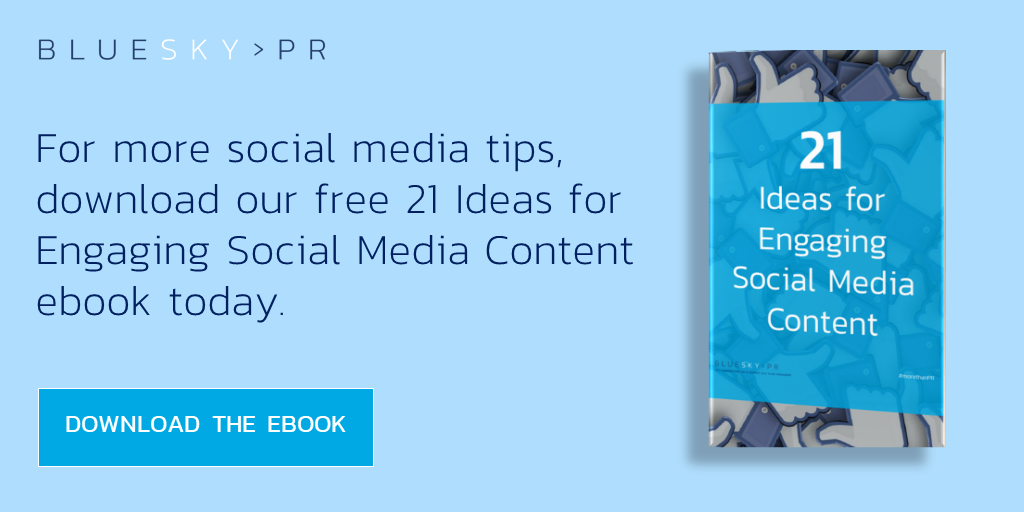Recruitment Marketing

Contents
- What is recruitment marketing?
- Defining your target audiences
- The importance of content marketing for recruitment
- Recruitment marketing: The importance of keywords for blogs
- Why recruitment marketing should include long-form content
- Why hero content is a recruitment marketing dream
- Email marketing for recruitment
- Social media for recruitment
- Recruitment marketing trends for 2022 and beyond
- Analysing the performance of your recruitment marketing
What is recruitment marketing?
Recruitment marketing is the process of attracting and nurturing candidates, clients and potential staff to your recruitment firm. This involves moving prospects through the marketing funnel from the point of not being aware of your agency to registering their details or contacting your consultants.

Recruitment marketing has grown in popularity as agencies recognise the benefits that an effective strategy can deliver. This guide will provide an outline of what you can do to develop and enhance your firm’s recruitment marketing.
Defining your target audiences
Before you start planning your recruitment marketing activities it is vitally important that you have created and/or updated candidate, client and talent personas for your firm. Personas are fictional representations of your business’s ideal customers which enable you to clearly define and segment your firm’s audiences.
They will enable you to:
- Identify the talent that is the perfect fit for the roles you are recruiting for.
- Understand the most relevant channels to target candidates on.
- Produce tailored marketing content, such as blogs, social media posts and emails.
- Create alignment across your firm’s marketing and recruitment functions.
- Provide detailed data to feed into your overall recruitment marketing strategy.
Where to source data for candidate and client personas?
So how can you start gathering the data needed to develop your personas? Here are four simple methods that your recruitment firm can implement:
- Integrate it into the on-boarding process – you should liaise with your recruitment consultants to ensure they are asking relevant questions and recording the responses they receive into dedicated fields of your CRM system.
- Look at the LinkedIn profiles of candidates and clients – if their profiles have been completed and they actively use the platform, their LinkedIn accounts will provide a wealth of valuable information, from their employment history and qualifications through to the type of content that they engage with.
- Interview previously hired candidates – you should work with your consultants to ensure that their follow up communications with successfully placed candidates include questions on their career aspirations and interests. This will provide you with regular insights that you can use to develop and refine your candidate personas.
- Send out targeted surveys that offer an incentive – you should segment your database into small groups and target individuals with themed surveys featuring questions relevant to their job roles. For example, you could design one that aims to find out the most common struggles faced when applying for a new role or what the biggest challenges facing HR directors are. Offering a small prize or incentive, such as a gift card for a lucky respondent, will help increase participation.
What questions should you ask?
To gain the insights needed to produce accurate candidate, client and talent personas, you should ask a diverse range of questions. It is recommended that you ask questions from each of the six categories in the template below.

How can you analyse data to produce candidate, client and talent personas?
Once you have collated this data you will need to carefully work through it to identify any recurring themes or trends and use this to highlight your audiences’ key characteristics.
We recommend working with your recruiters to ensure that you are getting more than one function’s perspective. After you have finalised their ideal characteristics you should bring them to life by giving them a suitable name and image (like the example below).

These personas will provide you with a wealth of data that you can use to create tailored recruitment marketing content that targets your ideal audiences.
The importance of content marketing for recruitment
Content needs to be at the heart of every recruitment marketing strategy. When produced and utilised correctly it enables your business to generate brand awareness, build relationships with candidates, clients and bring your overall marketing costs down.
What is content marketing?
Content marketing in recruitment is a strategic approach focused on creating and distributing content that is valuable, consistent and relevant to your audience in order to attract, engage and retain candidates,clients and potential new staff.
Instead of simply posting about jobs you are hiring for or the services you offer, you are producing content that educates or adds real value to prospects to help them solve any issues or pain points they may be experiencing.
Recruitment firms needs to use a variety of methods and channels if they are to reach prospective candidates, clients and employees with the right content at the right time, from email marketing through to social media.
Four types of content to enhance your recruitment marketing activities
-
Blog posts
Blogging is one of the most popular types of content marketing for recruitment businesses as it enables them to demonstrate their knowledge of the sectors they specialise in, provide thought leadership and offer advice to candidates, clients and potential new hires.
Blog posts can be incredibly effective when authored, or ghost-written, by different employees in your company, from the CEO to the heads of division or marketing manager. This enables you to present a diverse range of insights and opinions from across the business.
-
Infographics
Infographics are a fantastic way to illustrate detailed information and statistics in a visually engaging yet easily digestible format for readers.
Infographics are incredibly versatile and can be used as part of a blog post to provide additional context, or posted separately on social media as a piece of stand-alone content.
-
Podcasts
Podcast consumption witnessed a huge increase in 2020 with 9.4 million weekly listeners in the UK – an uptick of 45% over the previous 12 months. And because of this, many recruitment firms and suppliers are now producing their own podcasts to capitalise on this growing demand for audio content.
Podcasts help to humanise brands and give them a voice that candidates and end-hirers can relate to. They also help businesses by providing them with a unique opportunity to present their take on the latest industry trends, offer advice and share insights into their company culture – which can be extremely beneficial for employer of choice messaging when hiring internally.
-
Video
Video is another form of content marketing that has seen exponential growth in the recruitment industry over the last few years, particularly during the pandemic where working from home has led to a huge increase in videos being produced for social media.
These have more often than not taken the form of talking head videos, where an individual talks directly to the camera of their smartphone or laptop. These are an incredibly effective outlet for recruitment professionals to get themselves in front of their audiences on social media. While they may lack the polish that a professionally filmed video possesses, the rawness adds to the authenticity and you can brand the videos up and add subtitles by using speech-to-text software.
Recruitment marketing: The importance of keywords for blogs
When it comes to producing blogs as part of your recruitment marketing activities it is critical that you ensure they are SEO optimised and feature the most relevant keywords for your topic of choice.
What are keywords?
When writing content, your ‘keyword’ or ‘key phrase’ is what sums up your topic. This is usually the query which readers enter into search engines or is very closely related to it. This can be a word, a phrase or even a question. Your effective use of the keyword, and the popularity of your content will determine how high up in the Google rankings you sit.
Which keywords work for recruitment blogs?
It is recommend that you stay away from short keywords when possible. One-worded or two-worded terms are extremely competitive and also very vague. For example, ‘branch manager’ will bring up countless results from all around the globe and may be useless in connecting you to your target audience.
Using what are known as long-tail keywords, however, will help you get in front of the right people and will drastically increase your chances of being seen. Long-tail keywords are longer and more specific phrases that search engine users are likely to type when they know what they are looking for. An example of this is ‘bank branch manager jobs’.
To find out which specific keywords to use, and essentially what your subject matter should be, try asking yourself “What do our clients want to know?” or “What are my candidates searching for?”.
Where, when and how to use keywords?
It is absolutely crucial to think of your keyword before you start writing. This will allow you to produce SEO effective work, plan your content strategically and stay on topic while writing.
Once you know which phrase you will use, there are three key places in your blog that they must appear in:
Title
The first place is the title. Spend some time thinking of a title that features the keyword but is also engaging for readers. This will help your blog be picked up by search engines and will also entice readers to click-through.
The opening paragraph
The second place the keyword should appear is the opening paragraph. When writing for Search Engine Optimisation, this section should include your most important keyword or key phrase and ideally it should be in the first sentence. When people are surfing the web, they are more likely to see the first few words of each paragraph, so don’t waste this prime opportunity to plug the keyword.
Subheadings
A well written blog post should feature subheadings which are used to breakdown the content into easily digestible sections for readers to consume.
It is important that one of these subheadings also contains the keyword. This is because search engines, such as Google, use subheadings to help understand the context of the content and analyse how relevant it is to the keyword and the user’s search query.
You should also use the keyword liberally throughout the body of your blog and include it in the meta details as well.
Why recruitment marketing should include long-form content
What exactly is long-form content? With so many different definitions online it can be hard to define. However, here at BlueSky PR we refer to long-form content ‘as a blog or article that is a minimum of 800-1,000 words long’.
Rather than the short and snappy 300-500 blogs of yesteryear, the purpose of long-form content is to provide valuable information to the reader. If you produce long-form blogs, for example, which are tailored towards your individual personas you can increase the time that they spend on your site as they will find that the content is informative and addresses their needs.
Why has long-form content become necessary?
Since blogging for business became popular in the early 2010s, search engine results ended up becoming full of articles that were trying to game their algorithms by using keyword stuffing. This is where webpages and their associated images and metadata are loaded with the same keyword over and over again in an attempt to manipulate their search ranking. This led to too much noise and too little value being displayed in Google’s search results and resulted in the platform making a number of changes designed to ensure that quality content rose to the top of its rankings.
Today, Google no longer just looks at how many times a keyword appears, but it also looks at other more relevant factors such as semantically linked keywords, the site’s overall authority, how long visitors spend on a page and, of course, the length of the content.
The benefits of long-form content for recruitment firms
-
Increased time on site
Producing well-written content that presents a comprehensive overview of a topic means that users are far more likely to spend a longer period of time on your website – which is an influential factor in your search engine ranking position.
This is backed up by analysis from Backlinko which found that websites with a high time on site are more likely to rank highly on search engine results pages. This is because it suggests to Google that visitors found that content informative enough to stay on the page rather than bounce off of it.
-
Positions your recruitment brand as an authority
Not only is increased time on site an influential ranking factor, but this is also very likely to increase your trust in the eyes of your target audience.
For example, if you are a prospective candidate searching for interview advice which piece of content would be more valuable? A short 300 word blog which touches upon the basics from Firm A? Or a 1,000 word blog which goes into depth on the key things you need to get right from Firm B? And how would your perception of Firm A differ to Firm B after reading each blog?
-
Increases social media sharing
Long-form content that contains detailed advice, insights or analysis is proven to persuade people to share it. This is because the more useful the content is to them the more likely they will share it to their own online networks. Research from Moz found that ‘long form content of over 1,000 words consistently receives more shares and links than shorter form content’.
You should consider adding a social sharing button to your blogs to help facilitate this and simplify the process needed to share content to social media.
-
Long-form content can be evergreen
Because of the in-depth overview of a topic that long-form content takes, it is likely that the content will be evergreen.
Evergreen content is content that is relevant now and long after it is published. This means that when written correctly it can continue to hold a strong search engine ranking position and generate traffic months, if not years after its creation making it a vital part of your recruitment marketing arsenal.
-
It can generate leads and increase conversions
Because of its length, long-form content can also be used to strategically generate leads. Think about breaking up the space of content which is 1,500+ words with calls-to-actions that relate to the topic at hand. This could be ebook downloads or links to for candidates to submit their CV.
Why hero content is a recruitment marketing dream
Hero content is a meaty piece of content that can be repurposed into lots of different formats. For example, part of your recruitment marketing strategy may include surveying candidates and clients.
The output from this activity can be turned into reports or white papers which can be hosted as gated content on your website and marketed out through social and e-marketing campaigns to help you capture leads.
The main themes of the report could then be turned into a press release which in turn will generate coverage for you to showcase through social media. The findings could also be repurposed into a series of themed blogs with the top level results being featured in an infographic – the opportunities for repurposing this type of content is endless.
How to create hero content
We quite often hear recruiters make statements like “We don’t really have enough to talk about – not enough to produce a robust report”. As a result, they often focus on writing about what they do rather than what they know. However, recruitment professionals know far more than they give themselves credit for - they know about the people agenda. This is the knowledge regarding:
- Pay going up or pay going down and what’s driving that
- Skill shortages and what’s driving those skill shortages
- Talent pools and pipelining
- Global and regional comparisons
- Diversity in the workplace
- Leadership
- The future workplace
- Employability
And recruitment firms will have tonnes of data that will support any of these themes. So, if you are responsible for recruitment marketing in your organisation then have regular 10-minute brain dumps from the consultants in the business on some of the topics above. Ask them what the current pain points of their clients and candidates are and look at how the data in your business can be sliced and diced to support the themes of the content.
Email marketing for recruitment

Email marketing can be an extremely effective channel for recruitment firms enabling them to communicate with potential candidates and clients on a regular basis. However, to get the most out of this recruitment marketing channel it is critical to ensure best practice is implemented. Here are 14 tips that you should follow:
-
Build a compliant email marketing list
To kickstart your email marketing campaign you need to make sure that you have a list of GDPR compliant contacts on your CRM system that would be interested in hearing about what your recruitment firm is up to.
You can then build on this pool of contacts by ensuring that prospects have opportunities to provide their contact details with you on your website by creating lead generation activities, such as a simple newsletter sign up form, or through gated content.
-
Define your audience and establish goals
Next you should clearly outline your audience and set goals for your campaign. For example, are you sending an email to your candidates or your clients? And what kind of content does your audience want to receive?
This will not only enable you to clearly define the purpose of your email campaign and ensure it works in tandem with your other recruitment marketing channels, but also set measurable goals to evaluate its performance.
-
Segment your audience
Once you have built your initial list and identified your audience, you should segment this into specific target groups so that you can send them custom emails that feature content which is relevant to their individual interests.
Segmenting your audience and providing tailored content will result in fewer unsubscribes, higher open and click through rates, and prospects that are far more likely to turn into qualified leads.
-
Personalise your emails
Personalisation can dramatically improve the open and click through rates of your email campaigns. Try writing as if you are directly writing to one recipient by using their first name, speak to them by using ‘you’ and sign it off using the name of the most relevant member of staff to that specific sub-group.
-
Feature valuable content
You must make sure that your message is aligned with your goal and contains relevant and valuable content that is informative, useful and educational to ensure that recipients consistently open your emails and take the relevant actions. If you feature job posts and nothing else, it is likely to result in an increase in unsubscribes.
-
Include clear calls to action
Every email campaign that you send should have one or more clear calls to action that encourage your recipients to take action. Whether that’s finding out more about the jobs of the week, reading the latest candidate advice blog or downloading an ebook, writing a clear and direct CTA will direct users to the appropriate landing page on your website.
-
Add social sharing buttons
Including social sharing buttons in your email campaigns will allow you to promote your message to a wider audience as it allows subscribers to share your content. This, in turn, will help generate new leads for the business.
-
Craft a compelling subject line
A subject line is the first thing that subscribers will see in their inboxes. Therefore it’s essential that you craft a subject line that stands out among the hundreds of other emails that are vying for their attention from not only other recruitment firms, but also their friends, family and brands from other industries.
-
Make your email scannable
With the average person receiving 121 emails per day, it’s vital that once they’ve opened your email that the messaging is clear and easy to read otherwise they’ll simply close it and click delete.
You should use plenty of white space, bullet points and headings to break your content up into clear sections and avoid long blocks of text.
-
Optimise for mobile
With 46% of all emails opened on a mobile device, it is essential that your email is mobile-friendly and uses a responsive design. This will ensure that the content is still easy to read on the screen of a mobile phone and that all links are easily clickable.
-
Send a test email
Before sending your email to your list, make sure that you send a test email to yourself, a colleague and ideally a Gmail account. This will allow you to get it proofed by a second set of eyes, make sure that all links work and that it displays correctly on a different email service to the one that you use internally.
-
A/B test your email
A/B testing is incredibly useful to see what tweaks resonate most with your audience. This is where you make two versions of the same email and send one to one half of your list and a slightly different version to the other. You can test various elements such as:
- HTML formatting vs. text only
- Varying colour schemes
- Different orders for the content that features in the email
- Call to action wording
- The times you send your emails out
-
Make it easy to unsubscribe
It is important that you make the unsubscribe process as easy as possible. You should ideally have an ‘unsubscribe’ or ‘manage subscription’ option in the footer of your email which lets them change their email preferences.
-
Regularly clean and update your email list
Make sure that your contacts are kept relevant by removing those who do not open your emails and deleting undeliverable email addresses and bounce backs. This will ensure that your emails are only going to those who are engaging with your content and will dramatically improve your open rates going forward.
Social media for recruitment
With over 45 million users in the UK alone, social media has become a vital component of a recruitment agency’s marketing strategy in recent years, providing a multitude of ways for recruiters to source and engage with new talent and develop a strong brand presence in their respective markets. Yet there are still many firms out there failing to recognise how social media can help them achieve their top-level business objectives.
Here are just some of the ways that social media can benefit your recruitment marketing:
- Employer brand – With 59% of potential employees using social media to learn more about prospective employers, the need to promote a positive brand experience across your channels has fast become an essential part of the candidate attraction process.
This has become increasingly important in recent years as research shows that 88% of millennials, a group that is set to make up 75% of the global workforce by 2025, want to work for a company with values that reflect their own. Therefore, recruitment firms that highlight their cultures and values on social media are much more likely to attract high-calibre talent. - Recruiting – Over the last decade or so, social media has provided recruiters with the opportunity to create a strong digital presence where they can reach, engage with and source both passive and active candidates. And, of course, while LinkedIn immediately springs to mind, many recruiters are also having success on Twitter, Instagram and Facebook, as well as newer platforms such as TikTok.
- Candidate screening – With many candidates including social media links on their CVs to help showcase their passion and knowledge of a particular industry, this means that recruiters can learn a lot more about individuals’ personal and professional qualities to see if they are the right match for the roles that they are hiring for.
- Reaching new and existing audiences – From using organic posts to keep your followers updated on the latest roles, blogs and industry news, to creating paid campaigns that target individuals that align with your personas, social media has a number of options that can enable your firm to get its content in front of the right audience at the right time.
- Maximising marketing and PR activities – Social media provides recruitment firms with another channel to amplify their ongoing marketing and PR efforts and generate a higher ROI. From running a multi-channel brand campaign to showcasing top tier PR coverage, social media provides a number of ways in which companies can leverage their content to increase brand awareness.
For more information on using social media as part of your recruitment marketing visit our dedicated page on the topic.
Recruitment marketing trends for 2022 and beyond

The impact of the pandemic has transformed the way we live and work. This has meant that recruitment firms have had to remain agile and adapt their marketing strategies accordingly.
The power of online will continue to grow
With ‘in-person’ no longer the norm, the power of online – from company blogs and online media outlets, to social media platforms – will only proceed to increase over the year.
It is unlikely we will see a complete return to what we remember as ‘normal’ with a hybrid of the online or virtual PR and marketing activity that we’ve seen work during the pandemic and the more traditional methods that many of us miss.
This includes networking events, which are likely to evolve to include on and offline interaction on the day.
Brand reputation is critical
At times when budgets are tight, potential clients will turn to outside sources for information and guidance, even if they aren’t perhaps able to invest in outsourced providers to the extent they would like. But one thing is certain – they will remember the companies that supported them.
As such, we predict that over the next 12 months we will see more recruitment businesses turning their attention to building their brand profile as they position themselves as experts in their fields.
We can’t forget that candidate experience is still key in recruitment. Competition for the top talent will be rife, and the best applicants will be judging a business on how they managed their relationships with candidates during the crisis. The firms that have built a reputation for supporting the jobseekers they work with during tough times will certainly find that top talent will increasingly turn to them as we eventually move out of the pandemic. And we all know that those recruiters with the best candidates on their books will have the greatest competitive advantage.
Video will be an imperative tool
As we witnessed during the pandemic, in the absence of face-to-face interactions, video is definitely king. From talking head videos, to a shift in interviews recorded on Zoom, this communication tool has certainly grown in popularity and shows no signs of stopping.
Analysing the performance of your recruitment marketing

It is vital that you regularly analyse the performance of your recruitment marketing to ensure that your strategy is working. However, it is all too common for recruitment firms to rely on vanity metrics, such as the website traffic their site receives or the number of social media followers they have, when reviewing their data.
Here are seven marketing metrics that you can use on Google Analytics to assess the performance of your recruitment marketing strategy.
Seven Google Analytics metrics to use
-
SEO rankings
Discovering where your website pages and content rank on Google for the keywords they have been search engine optimised for is essential. After all, if you’ve noticed that your latest blog post is receiving little to no organic traffic whilst receiving plenty from social you will need to investigate and find out why this is.
-
Traffic volume
Measuring the traffic volume of your recruitment firm’s website is incredibly important. Whether your agency has local branches or not, your website is your virtual store and you should be utilising all of your recruitment marketing channels, such as social media and email marketing to drive relevant traffic to it so that you can nurture prospects over time depending on the actions that they take.
-
Traffic source
Measuring your website’s traffic sources enables you to filter by a number of methods to drill down and discover where users are coming from to view your website’s content.
For example, you can filter by traffic channel – where you can see the top level channel source, such as email marketing, social media and organic search, the source and medium – which displays where the traffic originated from, for example, Google/Organic, and the referral traffic – which shows you the website or platform that referred the traffic to your site, such as LinkedIn.
-
Bounce rate
A ‘bounce’ is a single-page session on your website. This means that someone has visited a webpage from a traffic source and has exited the site without taking any other action.
Traditionally, a high bounce rate is seen as a negative but it depends on the page that they land on. For example, if your homepage is suffering a high bounce rate then that, of course, should raise a red flag as it shows that visitors aren’t clicking to learn more about what you do as a business or the jobs you are currently recruiting for.
-
Location
Location is a metric that is often overlooked for some of the more quantitative ones that Google Analytics provides. However, if you have a job ad on your site for an HR Director position in Birmingham and a large percentage of those landing page visitors are from Exeter and Glasgow, you should be using this data to help understand why.
-
New vs. returning visitors
Monitoring how many users are returning to your website provides you with insights into what is working well and why they are visiting your site on a regular basis. For example, a high user retention is likely to show that your visitors are still looking for a job and that the blog content offers them plenty of value which will be a key factor in them returning as they will view you as a trusted source for career advice.
-
Goals
Goals are actions that can be set up and monitored to provide you with completion rates and tangible outcomes that you can feed back to the wider team. These are often actions such as submitting a CV, registering as a candidate or signing up for an e-newsletter.
Five email marketing metrics to use
As outlined earlier on this page, email marketing is an important channel for your recruitment firm. Here are five metrics you should be using to measure the impact of your campaigns.
-
Open rate
Open rate is the simplest email marketing metric to understand and tracks how many subscribers have opened the email sent to them.
This is vital for seeing how many received it and provides insight into the success of your subject line.
-
Click-through rate (CTR)
The click-through rate measures how many people have clicked on the links in your email. For example, if your email contained a round up of your latest blog content and top jobs the CTR would measure the percentage of subscribers that have clicked on those links.
-
Click-to-open rate (CTOR)
The click-to-open rate compares the number of unique clicks to unique opens. Unlike the click-through rate, the CTOR shows the number of clicks out of the number of opens. This helps you to understand how effective the email content and design was.
-
Bounce rate
The bounce rate is an important metric to track as it measures how many subscribers didn’t receive your email. This will be because of either soft bounces which are temporary problems with email addresses or hard bounces which are permanent issues.
-
Number of unsubscribes
Unsubscribes show you how many people have unsubscribed from your mailing list after receiving an email from you. A high number of unsubscribes can be viewed as a negative as they indicate the content is no longer relevant for the receiver, however, it can also be viewed as a positive because it shows that your subscriber list is made up of only those who want to hear from your firm.
Four key social media marketing metrics to use
Choosing the appropriate social media metrics is important if you are to assess how your social channels are performing and contributing to your recruitment marketing as a whole.
Here are four metrics you should include in your reporting:
-
Post reach and impressions
These two metrics will enable you to gauge how many users are being exposed to your content. Post impressions refer to how many times users have seen your content on their screens, while reach refers to how many unique users have seen it. Monitoring visibility enables you to see whether you are posting at the right times of the day and using the most relevant hashtags.
-
Click-throughs
If you are sharing content, such as company blogs and curated content to add value to your audiences, you should monitor the number of click-throughs your posts are receiving. This will allow you to see what types of content are generating the most clicks and inform your content mix.
-
Engagement
Each social media platform has its own way of measuring engagements, however, it is key to monitor the engagement rate of your posts and account as a whole to see what content is resonating with your audiences and what the most common forms of engagement are – whether it’s a like, share or comment.
-
Quality of followers
Many marketers are obsessed about building a high number of followers for their recruitment brand across their channels. However, it is much more important to have a small number of followers who are your ideal target audience rather than a large figure made up of bots and people who are unlikely to apply for the roles you are advertising.

















